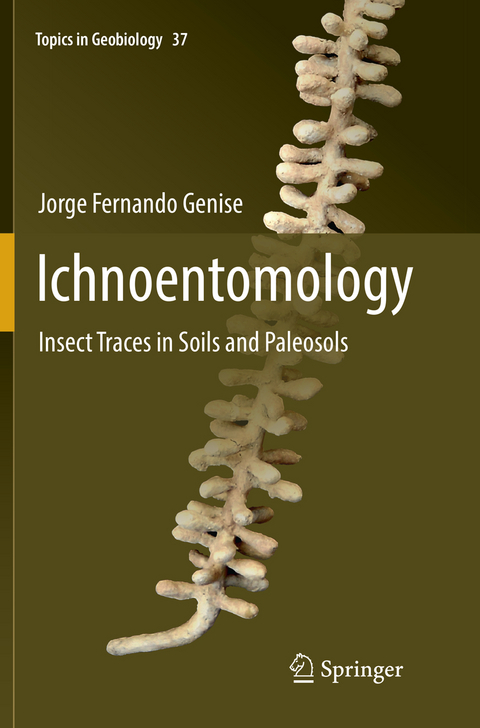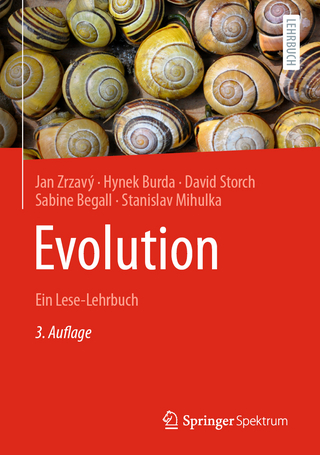
Ichnoentomology
Springer International Publishing (Verlag)
978-3-319-80298-5 (ISBN)
This book is devoted to the ichnology of insects, and associated trace fossils, in soils and paleosols. The traces described here, mostly nests and pupation chambers, include one of the most complex architectures produced by animals. Chapters explore the walls, shapes and fillings of trace fossils followed by their classifications and ichnotaxonomy. Detailed descriptions and interpretations for different groups of insects like bees, ants, termites, dung beetles and wasps are also provided.
Chapters also highlight the the paleoenvironmental significance of insect trace fossils in paleosols for paleontological reconstructions, sedimentological interpretation, and ichnofabrics analysis. Readers will discover how insect trace fossils act as physical evidence for reconstructing the evolution of behavior, phylogenies, past geographical distributions, and to know how insects achieved some of the more complex architectures. The book will appeal to researchers and graduate students in ichnology, sedimentology, paleopedology, and entomology and readers interested in insect architecture.
Jorge F. Genise is a Principal Researcher for the National Research Council of Argentina and founder of the National Ichnological Collection and Division Icnología of the Museo Argentino de Ciencias Naturales, where with his team he works on insect traces, extant and fossil, particularly in soils and paleosols, a field in which he is a recognized international expert. He is member of the editorial board of Ichnos (The International Journal of Animal and Plant Traces), invited lecturer in international ichnological and paleoentomological congresses, and president of the First International Congress on Ichnology. He has published several book chapters, more than 130 scientific articles and directed several doctoral theses on insect ichnology.
Chapter 1 Introduction.- Chapter 2 The wall: where everything begins.- Chapter 3 Other characters: shape, fillings and further micromorphological characters.- Chapter 4 Classifications. The utopia of classifying the unclassifiable.- Chapter 5 The keys I. Celliformidae and Coprinisphaeridae.- Chapter 6 The keys II. Krausichnidae and Pallichnidae.- Chapter 7 Dung beetle masonry.- Chapter 8 Trace fossils of dung beetles.- Chapter 9 Basic architecture of soil nesting wasps and bees.- Chapter 10 Wasp and bee trace fossils.- Chapter 11 Blueprints of termite and ant nests.- Chapter 12 The trace fossil record of eusociality in ants and termites.- Chapter 13 Other insect trace fossils in paleosols: cicadas, chafers, weevils and sphinx moths.- Chapter 14 Traces from nest invaders.- Chapter 15 Soil neighbors I: traces of other organisms in paleosols. Crustaceans and earthworms.- Chapter 16 Soil neighbors II: traces of other organisms in paleosols. Vertebrates and roots.- Chapter 17 Insect trace fossils in other substrates than paleosols I. Plant remains.- Chapter 18 Insect trace fossils in other substrates than paleosols II. Bones, caddisfly cases, trackways, imprints and aerial nests.- Chapter 19 Trace fossils as the physical evidence of evolution of insect behavior.- Chapter 20 (The most remarkable insect) ichnofabrics in paleosols.- Chapter 21 Paleosol ichnofacies.- Chapter 22 Paleoenvironmental analysis and ichnoentomological synthesis.
"In 695 pages the Argentine author Jorge Fernando Genise comprehensively describes the basics of ichnoentomology in order to encourage further research. For this very young scientific field, the book is an important milestone in advancing the study of insect traces and insect trace fossils. Insects and their traces in palaeosols have been observed and described by South Americans for about 200 years. Genise therefore had a good starting point. But what he made out of it over the years in his own research is truly remarkable. Luckily for all of us, he has written his knowledge down and published it in the present book." (Lothar H. Vallon, Paläozoologie)
"In 695 pages the Argentine author Jorge Fernando Genise comprehensively describes the basics of ichnoentomology in order to encourage further research. For this very young scientific field, the book is an important milestone in advancing the study of insect traces and insect trace fossils. Insects and their traces in palaeosols have been observed and described by South Americans for about 200 years. Genise therefore had a good starting point. But what he made out of it over the years in his own research is truly remarkable. Luckily for all of us, he has written his knowledge down and published it in the present book." (Lothar H. Vallon, Paläozoologie)
| Erscheinungsdatum | 05.03.2022 |
|---|---|
| Reihe/Serie | Topics in Geobiology |
| Zusatzinfo | XXVIII, 695 p. 397 illus., 289 illus. in color. |
| Verlagsort | Cham |
| Sprache | englisch |
| Maße | 155 x 235 mm |
| Gewicht | 10759 g |
| Themenwelt | Naturwissenschaften ► Biologie ► Evolution |
| Naturwissenschaften ► Biologie ► Ökologie / Naturschutz | |
| Naturwissenschaften ► Biologie ► Zoologie | |
| Naturwissenschaften ► Geowissenschaften ► Geologie | |
| Schlagworte | Entomology • Evolution • Ichnology • Insects • paleoenvironmental • Paleosols • Trace fossils |
| ISBN-10 | 3-319-80298-4 / 3319802984 |
| ISBN-13 | 978-3-319-80298-5 / 9783319802985 |
| Zustand | Neuware |
| Informationen gemäß Produktsicherheitsverordnung (GPSR) | |
| Haben Sie eine Frage zum Produkt? |
aus dem Bereich


